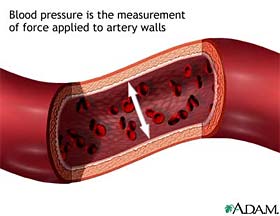What is Blood Pressure? What is Hypertension?
 Blood pressure is the force of the blood pushing against the walls of the arteries as the heart pumps blood through the body. Every time your heart beats it pumps out blood into your arteries. The pressure is determined by the force and amount of blood pumped and the size and flexibility of the arteries.
Blood pressure is the force of the blood pushing against the walls of the arteries as the heart pumps blood through the body. Every time your heart beats it pumps out blood into your arteries. The pressure is determined by the force and amount of blood pumped and the size and flexibility of the arteries.
Your blood pressure is at its highest when the heart beats, pumping the blood. This is called systolic pressure. When the heart is at rest, in between beats, your blood pressure falls. This is the diastolic pressure.
Blood pressure is always given as these two numbers, the systolic and diastolic pressures. Both are important. Usually they are written one above or before the other, such as 120/80 mmHg.
The top number is the systolic and the bottom the diastolic. When the two measurements are written down, the systolic pressure is the first or top number, and the diastolic pressure is the second or bottom number (for example, 120/80). If your blood pressure is 120/80, you say that it is “120 over 80.”
Your blood pressure changes during the day. It is lowest when you are sleeping and rises when you get up. It also can rise when you are nervous, stressed-out, or active.
For most of your waking hours, your blood pressure stays pretty much the same when you are sitting or standing still. That level should be lower than 120/80. When the level stays high, 140/90 or higher, you have high blood pressure. With high blood pressure, the heart works harder, your arteries take a beating, and your chances of a stroke, heart attack, and kidney problems are greater.
What is Normal Blood Pressure?
A blood pressure reading below 120/80 is considered normal. In general, lower is better. However, very low blood pressures can sometimes be a cause for concern and should be checked out by a physician.
Health care providers classify blood pressures under 140/90 as either “normal,” or “prehypertension.” “Normal” blood pressures are lower than 120/80. “Prehypertension” is blood pressure between 120 and 139 for the top number, or between 80 and 89 for the bottom number.
Blood pressure readings of 138/82, 128/89, or 130/86 are all in the “prehypertension” range. If your blood pressure is in the prehypertension range, it is more likely that you will end up with high blood pressure unless you take action to prevent it.
What is High Blood Pressure?
A blood pressure of 140/90 or higher is considered high blood pressure. Both numbers are important. If one or both numbers are usually high, you have high blood pressure. If you are being treated for high blood pressure, you still have high blood pressure even if you have repeated readings in the normal range.
There are two levels of high blood pressure: Stage 1 and Stage 2
Stage 1: 140-159 90-99
Stage 2: 160 or higher 100 or higher* For adults 18 and older who:
This is true for or adults 18 and older who: are not on medicine for high blood pressure, are not having a short-term serious illness and do not have other conditions such as diabetes and kidney disease.
Note: When systolic and diastolic blood pressures fall into different categories, the higher category should be used to classify blood pressure level. For example, 160/80 would be stage 2 high blood pressure.
There is an exception to the above definition of high blood pressure. A blood pressure of 130/80 or higher is considered high blood pressure in persons with diabetes and chronic kidney disease.
Another name for high blood pressure is “Hypertension”. When it is caused by another condition, it is called secondary hypertension. Other names also include: “Essential hypertension”. “Primary hypertension” and “Idiopathic hypertension”.
High blood pressure is called “the silent killer” because it usually has no symptoms at all. Some people may not find out they have it until they have trouble with their heart, kidneys or other organs. When high blood pressure is not found and treated, it can cause such as:
- The heart getting larger, which may lead to heart failure.
- Small bulges (aneurysms) to form in blood vessels. Common locations are the main artery from the heart (aorta), arteries in the brain, legs, and intestines, and the artery leading to the spleen.
- Blood vessels in the kidney to narrow, which may cause kidney failure.
- Arteries throughout the body to “harden” faster, especially those in the heart, brain, kidneys, and legs. This can cause a heart attack, stroke, kidney failure, or even amputation of part of the leg.
- Blood vessels in the eyes to bleed, which may cause vision changes and can result in blindness.
Source of some of this material: National Heart, Lung, and Blood Institute
